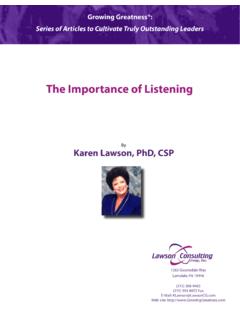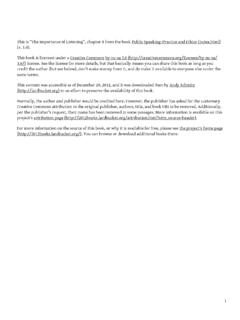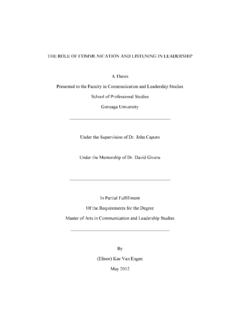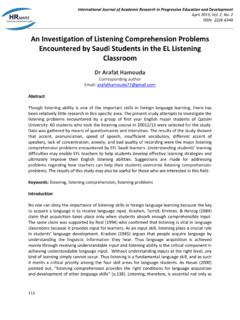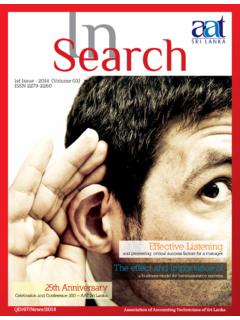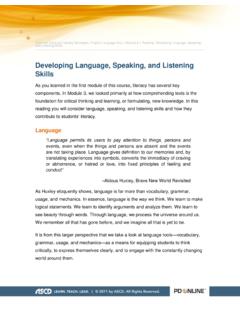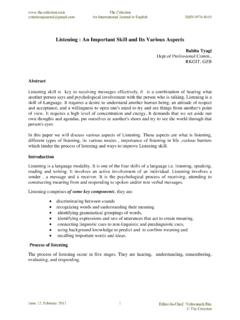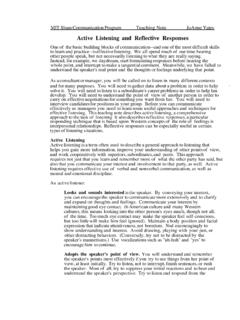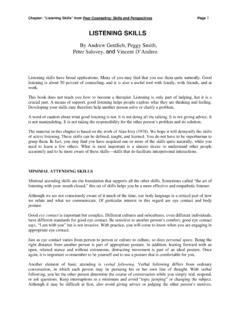Transcription of Patient Education and Counseling - Boulder & Broomfield
1 Communication StudyThe importance of physician listening from the patients perspective:Enhancing diagnosis, healing, and the doctor Patient relationshipJustin Jagosha,*, Joseph Donald Boudreaub, Yvonne Steinerta, Mary Ellen MacDonaldc, Lois IngramdaDepartment of Family Medicine, Faculty of Medicine, McGill University, Montreal, CanadabDepartment of Medicine, Faculty of Medicine, McGill University, Montreal, CanadacFaculty of Dentistry, McGill University, Montreal, CanadadIngram & Co., New York City, USA1. IntroductionListening is a complex and vital feature of clinical practice forphysicians. Despite attention paid to teaching and evaluatinglistening in clinical Education [1 3] and practice [4 11], very littlehas been published on physician listening from the Patient sperspective. Elucidating this perspective contributes to theliterature and provides empirical evidence on the role and functionof listening for medical listening to the Patient has been increasingly accepted asintegral to good medical care, two shifts in healthcare over the pastfew decades provide compelling arguments for understanding itsrole and function.
2 First is the shift in disease prevalence from acute,infectious and single organ diseases to chronic, complex and oftendegenerative or incurable conditions [12]. Second is the increasedcomplexity of healthcare service delivery due to progress in medicalscience and technology [13]. Given these shifts, it is important tounderstand why physician listening is important and how it maycontribute to clinical outcomes and Patient communication skills training has been seen toimprove health outcomes [14]. A notable benefit is that attentivelistening early on in the Patient interaction is associated with agreater likelihood that all of the patients complaints or issues will berevealed; in other words, there is a reduction in so-called late-arisingconcerns during the encounter [15]. However, physician listeningmay have benefits far beyond accurate reception, reporting, andrecording of Patient complaints.
3 Our data demonstrate an expandedrange of reasons why physician listening is listening definedThe International listening Association defines listening as theprocess of receiving, constructing meaning from, and respondingto spoken and/or non-verbal messages [16]. Despite the consensuson the importance of listening as a critical element in communi-cation skills, surprisingly little attention has been paid to itsdefinitions in clinical settings and its putative roles in Patient of the challenges is the fact that constructing meaning fromand responding to patients is a highly subjective endeavour, Patient Education and Counseling 85 (2011) 369 374A R T I C L E I N F OArticle history:Received 20 September 2010 Received in revised form 21 January 2011 Accepted 23 January 2011 Keywords:ListeningDoctor Patient communicationPatient perspectiveA B S T R A C TObjective: The research findings reported here describe the importance and various functions ofphysician listening according to : Fifty-eight patients of the McGill University Health Centre were interviewed using aqualitative, interpretive design.
4 Patients explained why listening was important to them and these findings were organized intothree themes: (a) listening as an essential component of clinical data gathering and diagnosis; (b) listening as a healing and therapeutic agent; and (c) listening as a means of fostering and strengtheningthe doctor Patient relationship. The findings are presented along with a conceptual model on thefunctions of physician : Elucidating the multiple functions of listening in the clinical encounter from patientperspectives can assist physicians in improving their listening implications: For training purposes, we recommend that a module on listening should lead to adiscussion not only about the skill required in listening attentively, but also to the values, beliefs,attitudes, and intentions of physicians who choose to listen to their patients. This teaching objective maybe facilitated by future research that explores the concept of authenticity in a physician s listeningapproach, which we argue is central to successful clinical outcomes.
5 2011 Elsevier Ireland Ltd. All rights reserved.* Corresponding author at: Department of Family Medicine, McGill University,517 Pine Ave, Montreal, Canada H2W 1S4. Tel.: +1 604 565 address: (J. Jagosh).Contents lists available at ScienceDirectPatient Education and Counselingjo ur n al h o mep ag e: w ww .elsevier .co m /loc ate/p ated u co u0738-3991/$ see front matter 2011 Elsevier Ireland Ltd. All rights for Anonymous User (n/a) at Boulder Community Hospital from by Elsevier on July 10, personal use only. No other uses without permission. Copyright 2017. Elsevier Inc. All rights challenges for measuring and evaluating listening is challenging because the act of listening is subjective,abstract, subtle, and internal. In addition, educational models ofclinical listening distinguish between active and passive listening , in which the physician quietly listens but withoutnecessarily engaging with the Patient to address their concerns, canbe seen as problematic.
6 Active listening [17] and attentivelistening [18] on the other hand are emphasized in medicaltraining. For example, the Calgary-Cambridge guide to communica-tion skills outlines four areas where active listening may have abeneficial impact. These include (a) wait time; (b) facilitativeresponse; (c) non-verbal skills; and (d) picking up verbal and non-verbal cues [1]. Missing from this and other similar models however,is description of the functions of listening from a Patient article is focussed on that critical BackgroundIn 2005, the undergraduate medical school curriculum at McGillUniversity was reorganized and oriented to address physician-ship : the explicit teaching of the physician s two roles as healerand professional, founded on the belief that the primary mandateof medicine is healing and the relief of suffering [18]. In tandemwith curricular renewal, patients were consulted on the reforminitiatives to guide curricular development.
7 The overall findings ofthe study have been published elsewhere [19]. The findingspresented in this article are a subset of the data from that study inwhich patients were asked to convey their attitudes, perceptions,thoughts, and feelings about their experiences with physician MethodThe study used an interpretive description (ID) design [20]. IDfalls within a constructivist paradigm which assumes that allknowledge is partial and subjective, and that research data are co-constructed by the participant and the researcher. We used IDbased on the idea that patients subjective experiences are a validand essential location for health care research inquiry, given thebelief that change to applied clinical disciplines should come fromengaged dialogue with the relevant parties ( , patients, healthcare providers). Following these philosophical and theoreticalassertions, our study has engaged patients in dialogue about whatreally matters to them in the spirit of addressing and improvingour Patient -centered approach to SettingData was collected from the teaching hospitals of the McGillUniversity Health Centre (MUHC).
8 The research protocol wasgranted ethics approval by the MUHC research ethics participants were all recruited from seventeen adultclinical sites of the MUHC, through the recommendations ofreferring clinicians in each of those SamplingParticipant selection was conducted initially through quotasampling a statistically non-representational strategy in which asampling matrix is constructed with independent variables. Quotasampling was employed to ensure maximum variation acrossdemographics (particularly cultural and linguistic), clinical sites,and health/illness status. In total, 58 participants were recruitedduring the period September 2005 April 2006. The sample wasdiverse in terms of reason for seeking medical care, occupation,and linguistic/cultural background. 10 interviews were conductedexclusively in French, 3 involved a mixture of French and English,and the remaining 45 were conducted exclusively in more than half our sample (55%) reported having auniversity Education .
9 This figure may not accurately reflect thegeneral level of Education in the Patient population receiving careat the MUHC, given that this institution provides care to significantnumbers of urban inner-city poor and disadvantaged refugeepopulations. We believe this over-representation may be attribut-ed to the fact that referring clinicians selected patients who theyfelt would be suitable for an interview on our research demographics are presented in Table InterviewsData were obtained through semi-structured interviews. Theinterview script opened with a dialogue seeking personal accountsof illness and experiences with physicians and then moved on to anexploration of Patient expectations of physicians and targetedquestioning on the physician as a professional and healer. Theinterviews were transcribed and subject to an iterative thematicanalysis. Two authors (JJ, JDB) coded all of the interviewsseparately.
10 They then met repeatedly to discuss the themes thathad emerged and integrated their analyses. Other members of theresearch team read a subset of transcripts to corroborate emergingthemes. Final results were agreed to by team consensus. Additionaldetails of the research methodology, in particular the process ofinterview script development and its piloting, along with anoutline of the original script, has been reported previously [19,21].In the early stages of data collection we observed the highfrequency with which participants independently identifiedlistening as the primary defining feature of a good doctor. Atypical response to the question, How would you describe thequalities of a good doctor? was: I would say a good doctor issomebody who will listen to what the problem is and explain to youwhat it is and what is being done. Although the research protocolhad not purposefully set out to explore physician listening , wefound the data obtained to be salient and from 2 of our 58 interviews did not get produceddue to recorder malfunctioning during the interview.


